The Haitian Nesophontes was described in 1929 based on subfossil remains that were recovered from cave deposits on the island of Hispaniola.
*********************
edited: 14.05.2022

The Haitian Nesophontes was described in 1929 based on subfossil remains that were recovered from cave deposits on the island of Hispaniola.
*********************
edited: 14.05.2022
Iberian Lynx Louse (Felicola isidoroi)
The Iberian Lynx Louse was described in 2001; it is known from a single male specimen.
The species’ disappearance is an example of a conservation-induced extinction: it died out when the last survivors of its host species, the Iberian Lynx (Lynx pardinus (Temminck)), themselves being at that time highly in imminent danger of extinction, were taken into captivity and de-loused.
***
The Iberian Lynx itself has made a decent comeback with the population now being at 1668 individuals in May of 2023.
*********************
References:
[1] Jesus M. Perez; Ricardo Palma: A new species of Felicola (Phthiraptera: Trichodectidae) from the endangered Iberian lynx: another reason to ensure its survival. Biodiversity and Conservation 10(6): 929-937. 2001
*********************
edited: 15.01.2024
Translucent Amastra Snail (Amastra pellucida)
The Translucent Amastra Snail was described in 1895, it was restricted to the Wai’anae Valley on the island of O’ahu, Hawaiian Islands.
The species is named for the thin pellucid (translucent) texture of its shell, and it is one of only a few of which we know at least a little bit about the animal itself.:
“Animal of a uniform brown color; the head above and tentacles of a darker shade. the action of the heart is plainly visible through the thin texture of the shell. When first collected the pulsations were about fifty per minute, growing slower and fainter from day to day until the animal died.” [1]
*********************
References:
[1] George W. Tryon; Henry A. Pilsbry; a.o.: Manual of Conchology. Second series: Pulmonata. Vol 21: Achatinellidae (Amastrinae). 1911
*********************

Depiction from: ‘George W. Tryon; Henry A. Pilsbry; a. o.: Manual of Conchology. Second series: Pulmonata. Vol 21: Achatinellidae (Amastrinae). 1911’
(public domain)
*********************
edited: 28.09.2020
Sangihe Flying Snake (Chrysopelea rhodopleuron ssp. viridis)
The Sangihe Flying Snake was described in 1880 from a single specimen which was subsequently destroyed during World War II; it was originally described as a distinct species. This form was apparently restricted to the island of Sangihe, the largest of the Sangihe Islands, Indonesia (not Sulawesi as is often stated).
The snake reached a length of 1,4 m, it was bright green above and slightly paler below, parts of the head were yellowish colored. [1]
The status of this form is not known but it appears to be extinct.
*********************
References:
[1] J. G. Fischer: Neue Amphibien und Reptilien. Archiv für Naturgeschichte 215-227. 1880
*********************
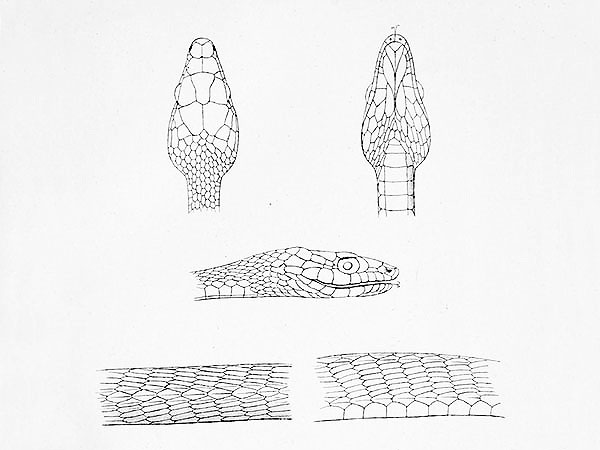
Depiction from: ‘J. G. Fischer: Neue Amphibien und Reptilien. Archiv für Naturgeschichte 46(1): 215-227. 1880′
(not in copyright)
*********************
edited: 19.08.2022
Sahlberg’s Aquatic Weevil (Echinocnemus sahlbergi)
Sahlberg’s Aquatic Weevil was described in 1911; it is known exclusively from the type series of four specimens that were collected from the Ayalon River in Tel Aviv, Israel, which now is almost completely channeled and probably quite polluted due to agriculture.
The species has not been found since its description and is thus very likely already extinct. [1]
*********************
References:
[1] Ariel-Leib-Leonid Friedman: Review of the Hygrophilous Weevils in Israel (Coleoptera: Curculionoidea). Diversity 10: 1-48. 2018
*********************
edited: 16.05.2022
This species was described in 1933, apparently based on a single specimen, a female: it has a wingspan of 2,2 cm; its wings have a light pinkish cinnamon color and bear several darker and lighter colored markings. [1]
The species was not found since and is considered possibly extinct. [2]
*********************
References:
[1] Louis B. Prout: The Geometridae of Christmas Island, Indian Ocean Bulletin of the Raffles Museum 8: 88-94. 1933
[2] John Woinarski: A Bat’s End: The Christmas Island Pipistrelle and Extinction in Australia. CSIRO Publishing, Victoria, Australia 2018
*********************
edited: 08.09.2020
This species was described in 2009 based on a single male specimen that was collected in March, April or May 1892 on the island of Mahé, Seychelles Islands.
The species was never found since its original collection and was thus considered extinct by its author. [1]
*********************
References:
[1] Adrian C. Pont: A new species of Coenosia Meigen, 1826 from the Seychelles Islands (Insecta, Diptera: Muscidae). Phelsume 17: 9-11. 2009
[2] Justin Gerlach: Red List ing reveals the true state of biodiversity: a comprehensive assessment of Seychelles biodiversity. Phesluma 20: 9-22. 2012
*********************
edited: 30.10.2020
This species was described in 1875, it is, or maybe was, restricted to the island of Saint Helena, where it appears to have been quite common.:
“It was chiefly at Plantation that I met with this species, where it abounds; indeed it is much too abundant, as in the caterpillar-state it is most destructive to the potato-crops. Mr. Melliss observes, “The larva of this moth is well known in the island as the potato-worm. It is a small, translucent, maggot-like creature, of a dirty whitish hue, marked with four longitudinal rows of small brown spots, and having a few long hairs on its body. In length it varies from a half to three quarters of an inch. The head is hard, and of a chocolate-brown colour; and the little creature moves backwards quite as easily as it does forwards. It abounds in the island, and is a thorough pest to the potato-crops. Either the eggs are laid in the potatoes, or the larva enters them in an early stage of its growth, and, through its depredations, renders them quite unfit for food. When changing to the pupa-state it wraps itself up in a strong web, in the form of a close, tough envelope; and the chrysalis is of a light mahogany colour, with the positions of the wings and legs, even in its early stage, strongly marked longitudinally down the outside of the case or skin.” It would therefore appear to be only in the more cultivated parts of the island that this species has established itself; and on rapping the trunks of trees in such situations the imagos fly off in showers; nevertheless they very quickly settle again.” [1]
The forewings are dull and opaque dark cloudy brown colored, they are more or less besprinkled with blackish scales; some individuals are darker; the hindwings are glossy, silk-like cinereous, becoming darker towards the apex. [1]
***
There are no recent records of that species, and it is possible that it is already extinct, which is weird given the fact that it apparently was able to adapt to introduced potatoes as larval food plant. [2]
*********************
References:
[1] Mrs. T. Vernon Wollaston: Notes on the Lepidoptera of St. Helena, with descriptions of new species. The Annals and Magazine of Natural History, including Zoology, Botany, and Geology. Ser. 5. Vol. 3: 415-441. 1879
[2] Timm Karisch: Darwin-Plus Project DPLUS040: securing the future for St Helena’s endemic invertebrates. Report Lepidoptera. Dessau, 31.08.2018
*********************
edited: 29.05.2021
The Saint Helena Opogona Moth was described in 1879, it is, or maybe was, restricted to the island of Saint Helena.
The species has not seen since its description and might very well be extinct. [1]
*********************
References:
[1] Timm Karisch: Darwin-Plus Project DPLUS040: securing the future for St Helena’s endemic invertebrates. Report Lepidoptera. Dessau, 31.08.2018
*********************
edited: 29.05.2021
Makaha Philodoria Moth (Philodoria costalis)
This species was described in 1934; it is known only from the forests of the Makaha Ridge at elevations of about 915 m above sea level on the western side of Mt. Ka’ala on the island of O’ahu, Hawaiian Islands.
The species reaches a wingspan of about 0,7 to 0,8 cm; the head, the thorax and the abdomen are tawny brown; the forewings are tawny brown and bear orange-colored patches.
The species is known to have mined the leaves of endemic māmaki species (Pipturus sp.); the sole description of its biology is the following sentence.:
“The larvae form “oval brown cocoons on the surface of the leaves ….” (Swezey, 1934: 525.)” [1]
***
The species was not recorded during recent field work and might be extinct. [2]
*********************
[1] Elwood C. Zimmerman: Insects of Hawaii 9; Microlepidoptera. University of Hawaii Press, Honolulu 1978
[2] Shigeki Kobayashi; Chris A. Johns; Akito Y. Kawahara: Revision of the Hawaiian endemic leaf-mining moth genus Philodoria Walsingham (Lepidoptera: Gracillariidae): its conservation status, host plants and descriptions of thirteen new species. Zootaxa 4944(1): 1-715. 2021
*********************
edited: 18.03.2021
Onore’s Stub-foot Toad was described in 2007, it is so far known only from the two localities in the Azuay Basin in the Cordillera Occidental in Ecuador, where it was discovered in 1990.
The species was photographed alive, the ground color of most individuals was orange-yellow, the dorsal areas of the males were variably colored bright green. The most conspicuous character of this species, however, were the aqua-blue colored iris of their eyes.
Onore’s Stub-foot Toad was never found again since its discovery and is believed to be already extinct.
*********************
References:
[1] Luis A. Coloma; Stefan Lötters; William E. Duellman; Alfonso Miranda-Leiva: A taxonomic revision of Atelopus pachydermus, and description of two new (extinct?) species of Atelopus from Ecuador (Anura: Bufonidae). Zootaxa 1557: 1-32. 2007
*********************
edited: 07.05.2019
This form is known only from subfossil remains that had been found on the island of Grande Terre, New Caledonia.
This was probably an endemic form of the Grey Teal (Anas gracilis Buller), a species that is otherwise known from Australia, New Guinea and New Zealand, however, this species is sometimes found on New Caledonia as a vagrant, thus it is also possible that the subfossil remains descent from such vagrant birds. [1]
The form is mentioned here for the sake of completeness.
*********************
References:
[1] David W. Steadman: Extinction and biogeography of Tropical Pacific Birds. University of Chicago Press 2006
*********************
edited: 10.11.2021
Raivavae Reed Warbler (Acrocephalus sp.)
No Reed Warbler species are known to inhabit the Austral Islands today, yet their former existence in that archipelago is more than likely, given the fact that such species are found on the Cook Islands to the north and on the Tuamotu archipelago to the east.
And, there is indeed at least one record of a reed warbler that was heard singing on one of the Austral Islands – Raivavae.:
“A. v. sous-espèce ?
Raevavae: des fauvettes furent entendues par Lacan (J.-L. Mougin, comm. pers.) en mai 1968.” [1]
translation:
“A. v. subspecies?
Raevavae: warblers were heard by Lacan (J.-L. Mougin, pers. Comm.) in May 1968.“
and:
“Une espèce non identifiée d’Acrocephalus a été notée à Raivavae en 1968 mais n’a pas été retrouvé en 1990 (Seitre et Seitre 1991) et pouvait donc être un oiseau erratique.” [1]
translation:
“An unidentified species of Acrocephalus was recorded at Raivavae in 1968 but was not found in 1990 (Seitre and Seitre 1991) and could therefore be an erratic bird.“
This one, brief record may in fact refer to a last remaining tiny population of an endemic reed warbler population that went extinct so after.
*********************
References:
[1] D. T. Holyoack; J.-C. Thibault: Contribution à l’étude des oiseaux de Polynésie orientale. Mémoire du MNHN, Série A Zoologie 27: 121-122. 1984
*********************
edited: 03.01.2024
Kawailoa Leptachatina Snail (Leptachatina fulgida)
The Kawailoa Leptachatina Snail was described in 1856; it was restricted t a small region within the Wai’anae Mountains on the island of O’ahu, Hawaiian Islands.
The shells are about 1.1 cm heigh; they are shiny dark brown and very finely striated, the apex is white. [1]
*********************

*********************
References:
[1] George W. Tryon; Henry A. Pilsbry; a.o.: Manual of Conchology. Second series: Pulmonata. Vol 21: Achatinellidae (Amastrinae). 1911
*********************
edited: 15.01.2024
This species was described in 1997, apparently based on collections made in 1978 in the Izmir Province of Turkey.
The species was not found since and might be extinct.
*********************
edited: 27.01.2022
Yellow Gorgon (Meandrusa payeni ssp. payeni)
The Yellow Gorgon can be spilt into about six subspecies, which occur from parts of China and India to Indonesia.
The species itself seems not to be threatened yet, however, the nominate form, which was restricted to the island of Java, Indonesia, appears to be extinct now.
***
The photo below shows another subspecies.
***
syn. Papilio payeni ssp. payeni Boisduval
*********************
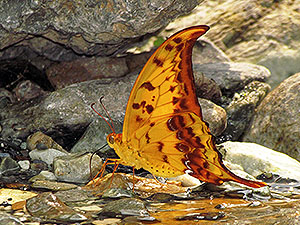
*********************
edited: 17.11.2021
Villiers’ Emerald was described in 1984; it is endemic to the island of Mwali (Mohéli) in the Comoro Islands.
The species is only known from one locality that seems to be highly degraded now, it has not been found in recent field studies and might well be extinct.
*********************
edited: 14.05.2022
The Tubuai Bark-gnawing Beetle was described in 2020, it is known from subfossil remains, including a head, parts of another head, a left mandible, at least one complete elytron as well as additional elytral fragments, and a incomplete prothorax, all recovered from sediment core samples taken at the Mihiru Swamp on the island of Tubuai in the Austral Islands.
These remains can be dated to an age of about 2500 to 2000 BP..
The Tubuai Bark-gnawing Beetle might have been the largest member of its genus, its size has been reconstructed to have been about 1,57 cm in length, which clearly sets it apart from the congeneric and sympatric Mihiura Bark-gnawing Beetle (Tenebroides mihiura Kolibáč & Porch). [1]
*********************
References:
[1] Jiří Kolibáč; Milada Bocakova; James K. Liebherr; Thibould Ramage; Nick Porch: Extinct and extant Pacific Trogossitidae and the evolution of Cleroidea (Coleoptera) after the Late Triassic biotic crisis. Zoological Journal of the Linnean Society 20: 1-37. 2020
*********************
edited: 02.11.2020
This species is known from a single specimen that was collected somewhere in Africa (all other known members of the genus occur there); it was described in 1793, originally as a skipper (Hesperidae).
The sole specimen was examined in 2018, when it was found not to be a skipper (Hesperiidae) at all but instead a member of a completely different family, the owlet moths (Noctuidae). [1]
The Lost Heraclia Moth has not been found for 229 years; it may well be lost forever.
*********************
References:
[1] Alberto Zilli; Nick Grishin: Unveiling one of the rarest ‘butterflies’ ever (Lepidoptera: Hesperiidae, Noctuidae). Systematic Entomology 44(2): 384-395. 2018
*********************
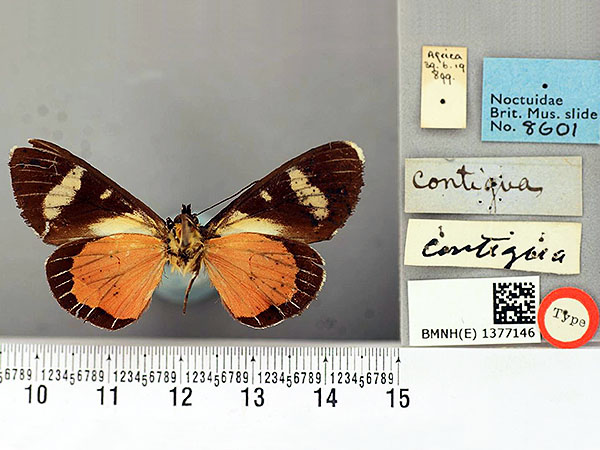
underside
Photo: The Trustees of the Natural History Museum, London
(under creative commons license (4.0))
https://creativecommons.org/licenses/by/4.0/
*********************
edited: 28.04.2022
Greater Koa-Finch (Rhodacanthis palmeri)
The Greater Koa Finch, named hopue by the native Hawaiians, was already nearly extinct when it was discovered by European ornithologists.
The species originally inhabited dry lowland forests that were dominated by the endemic koa acacias (Acacia koa A. Gray) whose seed pods and seeds apparently were its main food source, it furthermore fed on the seeds of the native ‘a’ali’i (Dodonaea viscosa Jacq.) and caterpillars. Most of the lowland forests had already been destroyed by the Hawaiian natives long before the first European settlers arrived, and the finches were restricted to the small remains in the northern Kona District in the western part of Hawai’i.
***
When alive, Greater Koa Finch was by far the largest of the Hawaiian endemic drepanidine finches; it reached a size of 23 cm; the males had bright scarlet-orange heads and breasts, while the females were more or less completely plain green colored.
***
syn. Loxioides kona Greenway, Psittiacirostra palmeri (Rothschild), Psittirostra palmeri (Rothschild), Telespiza palmeri (Rothschild)
*********************
References:
[1] H. Douglas Pratt: The Hawaiian Honeycreepers: Drepanidinae. Oxford Univ. Pr. 2005
*********************
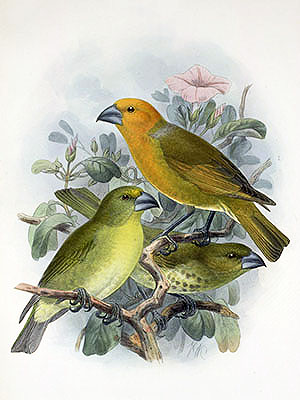
*********************
edited: 07.10.2020
Natural Tunnel Miliped (Conotyla vista)
This species was described in 1971; it is only known from a single specimen that was found in one of the so-called Natural Tunnels, a sandstone formation in the Grandview State Park in Raleigh County, West Virginia, USA.
“The male holotype is the only known specimen. The type locality … is a ridge of heavily faulted, coarse sandstone overlooking the 1200 foot [365,76 m] deep gorge of the new River. The Natural Tunnels are roofed crevices formed by downslope creeping of sandstone blocks and are long enough to have totally dark areas and at least some troglophilic species (…), but C. vista shows no cave modifications. ….” [1]
The species has not been found since and is considered possibly extinct, however, this certainly is not a true cave species and might sooner or later be found in the vicinity of its original type locality.
*********************
References:
[1] William A. Shear: The miliped family Conotylidae in North America, with a description of the new family Adritylidae (Diplopoda: Chordeumida). Bulletin of the Museum of comparative Zoology 141(2): 55-98. 1971
*********************
edited: 19.08.2022
Martinique Curly-tailed Lizard (Leiocephalus herminieri)
The Martinique Curly-tailed Lizard was described in 1837, the exact origin of the species is not known, but it is believed to have come from the island of Martinique.
The species is known from only five specimens, three of which are kept in the Muséum national d’Histoire naturelle in Paris, France; a skeleton is kept in the British Museum of Natural History, London, Great Britain; and the fifth one, preserved in spirit, was kept in the Rijksmuseum van Natuurlijke Historie in Leiden, Netherlands, but unfortunately was destroyed apparently following spirit removals in the collection.
The original data accompanying one of the three specimens in Paris gives the place of collection as “Trinite”, which is thought by some herpetologists to be Trinidad, but which in fact might well be the city of Trinite on the north coast of Martinique; the other two specimens in Paris are likewise thought to have been collected on Martinique. [1]
***
The Martinique Curly-tailed Lizard reached a size of about 30 cm (including the tail). [1]
The species disappeared shortly after its description, probably due to predation by introduced rats and Javan Mongooses (Herpestes javanicus (É. Geoffroy Saint-Hilaire)).
***
syn. Holotropis herminieri Duméril & Bibron
*********************
References:
[1] Gregory K. Pregill: Systematics of the West Indian Lizard Genus Leiocephalus (Squamata: Iguania: Tropiduridae). Miscellaneous Publications of the Museum of Natural History, University of Kansas 84: 1-69. 1992
*********************
edited: 07.09.2019
The Rockland Meske’s Skipper is a subspecies of Meske’s Skipper (Hesperia meskei W. H. Edwards) (see photo below) that was described in 2003 and that apparently was restricted to the Florida Keys, a coral cay archipelago off the southern coast of Florida, USA.
It was already nearly extinct when it was described.:
“The taxon is within the Key Deer Refuge on Big Pine Key and is therefore already afforded habitat and disturbance protection. However, the number of individuals have now declined so greatly that some type of breeding program seems called for soon if not immediately.” [1]
The butterfly was officially declared extinct in 2013.
*********************
References:
[1] Ronald R. Gatrelle: A subspecific assessment of the genus Hesperia (Hesperiinae) in eastern North America (part I: the south) New subspecies of Hesperia meteea, Hesperia sassacus and Hesperia meskei. The Taxonomic Report 4(3). 2003
*********************

Meske’s Skipper (Hesperia meskei), nominate form
Photo: Will Stuart
https://www.inaturalist.org/people/willstuart2001
(under creative commons license (4.0))
https://creativecommons.org/licenses/by-nc/4.0/
*********************
edited: 28.04.2022
The weevils (Curculionidae) are in fact the most species-rich family of the whole animal kingdom, the family is divided into several subfamilies of which the Cossininae is one.
***
The subfossil record of the island of Rimatara, Austral Islands has produced the remains of at least 18 (!) genera/species of cossinine weevils, this shows how species-rich the island faunas once, before the arrival of humans, were … and, how much has already been lost.
The remains are currently under review by Nick Porch, an Australian entomologist specialized in subfossil insect remains.
*********************
edited: 31.10.2020
The Rota Duck is known so far only from subfossil bones that were recovered from deposits on the island of Rota in the Mariana Islands.
The species was small and probably flightless, not much else is known about it so far. [1]
*********************
References:
[1] David W. Steadman: Extinct and extirpated birds from Rota, Mariana Islands. Micronesia 25(1): 71-84. 1992
*********************
edited: 10.11.2021
Rupert’s Valley Weevil was described in 1972; it is, or rather was, endemic to the island of Saint Helena.
The species was obviously not seen since 1967 and might well be extinct, however, I was not able to find any additional information about this species.
*********************
edited: 27.05.2021
Edith’s Green Leafhopper, which is or was endemic to the island of Saint Helena, was described in 1878, however, its genus name is placed between quotation marks because it apparently is invalid and the species belongs in another genus.
This species was found by Mrs. and Mr. Wollaston at Cason’s, Diana’s Peak, and high Peak in the central ridge of the island, but was not recorded during field surveys in 1965/66 and during the most recent searches in 2005/06 and is probably extinct now. [1]
*********************
References:
[1] Howard Mendel; Philip Ashmole; Myrtle Ashmole: Invertebrates of the Central Peaks and Peak Dale, St. Helena. Report for the St Helena National Trust, Jamestown 2008
*********************
edited: 02.12.2018
The Domed Rodrigues Giant Tortoise was one of two tortoise species that formerly were endemic to the island of Rodrigues in the Mascarene Islands.
The species disappeared after the island was settled by Europeans in the 16th century, the last individuals survived apparently until the very beginning of the 19th century.
*********************
edited: 19.01.2020
Upland Combshell (Epioblasma metastriata)
The upland scallop lived in shallow areas including the Black Warrior and Cahaba rivers in Alabama and the Coosa River basin in Alabama, Georgia and Tennessee, USA.
The shell of the species reached a width of up to 6 cm.
The last living specimen of this species was collected from the Conasauga River in Georgia in 1988.
***
syn. Dysnomia metastriata Conrad
*********************
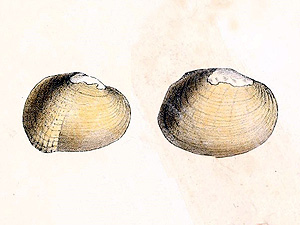
*********************
edited: 29.07.2012
The Puebla Deermouse was described in 1898, it is known only from two specimens which were collected at the cities of Ciudad Serdán and Tehuacan in southeastern Puebla, Mexico.
The species was last seen around 1948, the places where it was found are now heavily degraded by agricultural conversion and it is believed to be extinct.
*********************
edited: 23.01.2020
Radofilao’s Sloth Lemur was described in 1990 based on subfossil remains that were found in some limestone caves along the northern coast of Madagascar, and which could be dated to ages of about 3100 to 2800 BCE..
*********************
edited: 16.05.2022
Alejandro’s Cerion Snail (Cerion alejandroi)
Alejandro’s Cerion Snail was described in 2019 on the basis of subfossil shells that had been collected from deposits at a place named El Júcaro, near the Ramón de Antillas beach in the Holguín Province of Cuba.
The shells reach sizes of about 2,3 to 2,49 cm in height; they have a rather barrel-shaped form. [1]
The species apparently disappeared at the beginning of the Holocene du to naturally occurring changes in the local climate.
*********************
References:
[1] Alexis Suárez: Descripción de dos especies nuevas de Cerion (Mollusca: Pulmonata: Cerionidae) en estado subfósil, para Holguín, Cuba. Novitates Caribaea 14: 121-127. 2019
*********************
edited: 01.11.2020
Qilu Carp (Cyprinus ilishaestomus)
The Qilu Carp was described in 1977; it was endemic to the Qilu Lake in Yunnan, China.
This species was last found in the late 1970s and is now very likely extinct.
*********************
edited: 18.05.2022
Grand Cayman Oriole (Icterus leucopteryx ssp. bairdi)
This bird, as its name implies, was restricted to the island of Grand Cayman while the nominate race is endemic to Jamaica.
The bird is mainly golden yellow colored with a greenish hue; its face and throat are black; the wings are largely white and black and the tail is black as well; the beak and the feet are grey.
The last birds were collected in 1911 by Wilmot W. Brown (at a time when the Governor of the island specifically forbade him to hunt any birds peculiar to the island, by the way), and the collector wrote the following statement.:
“Collection contains 17 specimens of the very rare Icteurs bairdi – the rarest bird I ever hunted!” [1]
*********************
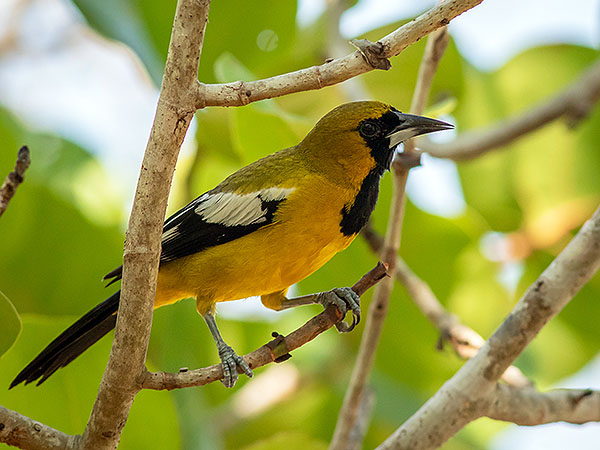
*********************
References:
[1] Kevin B. Clark: Wilmot W. Brown: one of the most prolific collectors of the vertebrate fauna of the New World. Bulletin of the Museum of Comparative Zoology at Harvard College 126(6): 347-378. 2020
*********************
edited: 05.01.2024
Yunnan Carp (Cyprinus yunnanensis)
The Yunnan Carp was described in 1933; it was restricted to Lake Qilu in Yunnan, China.
The littoral zone of the lake was destroyed by agricultural development, leading to a drop in the water level due to water extraction; furthermore, many species of foreign fish appear to have been introduced to the lake and probably feeding upon the eggs and larvae of the native fish species.
The Yunnan Carp was last found in the 1970s and is now apparently extinct.
*********************
edited: 15.02.2024
Spirits Bay Flax Snail (Maoristylus ambagiosus ssp. spiritus)
This taxon was described in 1947 based on subfossil specimens that were recovered from loose dunes between the camp sites of Kapowairua and Pandora at the Spirits Bay in the far north of New Zealand’s North Island.
Like many other former populations of this snail species, also this one apparently disappeared at the Pleistocene/Holocene border due to natural causes.
***
syn. Placostylus ambagiosus ssp. spiritus Powell
*********************
References:
[1] A. W. B. Powell: On further colonies of Placostylus land snails from northernmost New Zealand. Records of the Auckland Institute and Museum 4(2): 134-140. 1951
*********************
edited: 06.02.2024
The Christmas Island Emerald was described in 1933; it is, or rather was, endemic to Christmas Island in the Indian Ocean.
The species hasn’t been seen since the 1930s and might well be extinct. [1]
*********************
References:
[1] John Woinarski: A Bat’s End: The Christmas Island Pipistrelle and Extinction in Australia. CSIRO Publishing, Victoria, Australia 2018
*********************
edited: 02.05.2022
The Tricolored Anoma Snail was desribed in 1847, it apperas toe have been restricted to a place named Moncrieff Gully (named Fern Gully today) in the St. Ann Parish at the north coast of Jamaica. [1]
The shells reach sizes of about 1,8 cm in heigth, they have up to 15 whorls and are glossy whitish and bear some grayish stripes.
The species is apparently extinct now.
References:
[1] George W. Tryon; Henry A. Pilsbry; a.o.: Manual of Conchology. Second series: Pulmonata. Vol 16: Urocoptidae, Achatinidae. 1904
[2]
*********************
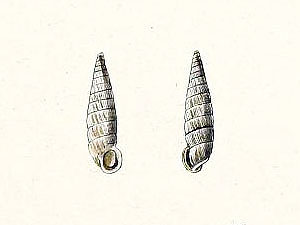
Depiction from: ‘Louis Pfeiffer: Die Gattung Cylindrella Pfr.: in Abbildungen nach der Natur. Nürnberg: Verlag von Bauer und Raspe, Julius Merz 1862’
(not in copyright)
*********************
edited: 22.09.2020
Socotra Cone-headed Katydid (Xenephias socotranus)
The Socotra Cone-headed Katydid was described in 1973 based on specimens that had been collected in 1967 at the Adho Dimellu pass on the island of Socotra at an elevation of about 1000 m above sea level.
The species reaches a body length of about 2 to 3 cm; it is generally testaceous and strongly mottled and speckled with sepia-brown markings; the head bears a narrow, postocular, grey streak, the eyes are brown, the antennae are greyish.
It seems that this taxon has never been recorded subsequently and that it may be extinct.
*********************
References:
[1] D. Keith McE. Kevan: A new genus of Pyrgomorphidae (Acridoidea: Orthoptera) from the island of Socotra. The Canadian Entomologist 105(9): 1169-1173. 1973
*********************
edited: 30.01.2024
Porto Santo Scops Owl (Otus sp.)
The Porto Santo Scops Owl is known from fragmentary subfossil remains, found on the island of Porto Santo northeast of Madeira.
This form might have been identical with the Madeiran Scops Owl (Otus mauli Rando, Pieper, Alcover & Olson), but it is quite possible that it was at least distinct at subspecific level.
*********************
References:
[1] Juan Carlos Rando; Harald Pieper; Josep Antoni Alcover; & Storrs L. Olson: A new species of extinct fossil scops owl (Aves: Strigiformes: Strigidae: Otus) from the Archipelago of Madeira (North Atlantic Ocean). Zootaxa. 3182: 29-42. 2012
*********************
edited: 02.05.2022
The Pallid Amber Snail was confined to the sister islands of Ra’iatea and Taha’a, where it was historically very abundant and could be found on any moist places on the ground.
The species, which was described in 1847, is now extinct.
*********************
References:
[1] Justin Gerlach: Land and Freshwater Snails of Tahiti and the other Society Islands. Phelsuma Press, Cambridge 2017
*********************
edited: 26.11.2018
This form differs from the nominate form by its smaller size, its compact and closely coiled spire, but especially in its smoother surface marked with finer and more distantly spaced growth-wrinkles. [1]
“This is an exceedingly rare form of Amastra. the results of five findings are six whole and three broken specimens. Among the large number of Amastras that have been taken in the Manoa fossil deposits, from the beginning of Oahu Avenue to Awapuhi Street, this form was only taken from four “pockets”.” [1]
These deposits appear to be actually Late Pleistocene to early Holocene in age.
*********************
References:
[1] C. Montague Cooke: New species of Amastridae. Bishop Museum Occasional Papers 10(6): 1-29. 1933
*********************
edited: 04.05.2022
The Ogasawara Holly Blue, described in 1886, is endemic to the Ogasawara Islands, where it appears to have been quite common until the 1970s, when its populations began to crash, mainly caused by the loss of their preferred host plant species due to the native vegetation being overrun by introduced invasive alien plants and because of increasing predation by likewise introduced Green Anoles (
Anolis carolinensis Voigt), whose populations are now as high as about 6 million individuals. [1]The species appears to be extinct in the wild since 2018, when the last individuals were seen.
For some time there had been attempts to establish a captive program: the species was kept in captivity since 2005, once in the Tama Zoological Park and then in the Shinjuku Gyoen National Garden, both in Tokyo, Japan.
However, these efforts apparently failed, and the last individuals apparently died in 2020.
The Ogasawara Holly Blue is now feared to have been lost.
*********************
References:
[1] Yasuhiro Nakamura: Conservation of butterflies in Japan: status, actions and strategy. Journal of Insect Conservation 15: 5-22. 2011
*********************

female
Photo: コミスジ空港
(under creative commons license (4.0))
http://creativecommons.org/licenses/by-sa/4.0
edited: 02.11.2020
Brown Kauaian Leptachatina Snail (Leptachatina laevis)
This species was described in 1869; it was restricted to the island of Kaua’i, Hawaiian Islands.
The shells reached heights of 0.9 to 0.95 cm; they were ovately oblong, imperforate, dextral, somewhat thin, smooth, glossy and dark brown colored.
*********************

*********************
References:
[1] George W. Tryon; Henry A. Pilsbry; a.o.: Manual of Conchology. Second series: Pulmonata. Vol 21: Achatinellidae (Amastrinae). 1911
*********************
edited: 14.01.2024
Lauopa Snail (Lauopa mbalavuana)
This species, the only one in its genus, was described in 1983 based on material that had been collected in 1938 under logs and stones in a dense forest on a limestone hill on the island of Vanua Balavu, Fiji.
As far as I know only two specimens were ever found and both of them appeared to have rather been in a subfossil state; this species almost certainly is extinct. [1]
*********************
References:
[1] Alan Solem: Endodontoid land snails from Pacific Islands (Mollusca: Pulmonata: Sigmurethra). Part II, Families Punctidae and Charopidae, Zoogeography. Field Museum of Natural History Chicago, Illinois 1983
*********************
edited: 21.08.2022
The Saddle-backed Rodrigues Giant Tortoise was endemic to the island of Rodrigues, Mascarene Islands in the Indian Ocean.
The species was heavily hunted by the European settlers in the 16th century for its meat and was finally wiped out at the end of the 18th century.
*********************
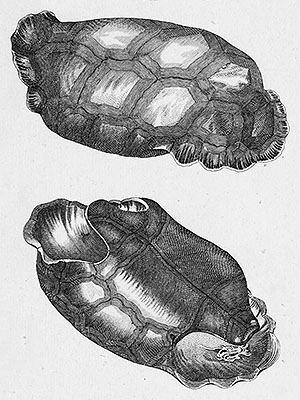
Depiction from: Joannis Davidis Schoepff: Historia testudinum iconibus illustrata. Erlangae: J. J. Palm 1792-1801
(not in copyright)
*********************
edited: 19.01.2020
Martinique Forest Thrush (Turdus lherminieri ssp.)
The Forest Thrush (Turdus lherminieri (Lafresnaye)) inhabits, respectively inhabited some of the islands of the Lesser Antilles, where it is known from Dominica, Guadeloupe, and Montserrat as well as from Saint Lucia.
The species is, however, not known from Martinique, which is located between Dominica and Saint Lucia, but almost for sure did once occur there as well and probably did so with an endemic subspecies; yet currently there is no proof so far for that assumption, thus I will only briefly mention this assumption here.
*********************
edited: 02.05.2022
This species was described in 1881; it was restricted to the island of Rarotonga, Cook Islands.
The shells reach sizes of 0,34 to 0,43 cm in diameter.
The species is now extinct.
*********************
References:
[1] Alan Solem: Endodontoid land snails from Pacific Islands (Mollusca: Pulmonata: Sigmurethra). Part II, Families Punctidae and Charopidae, Zoogeography. Field Museum of Natural History Chicago, Illinois 1983
*********************
edited: 02.08.2022
Bennu Heron (Ardea bennuides)
The ‘Benu’ or ‘Bennu’ is a mythological bird of ancient Egypt, of which there are numerous, very detailed depictions on temple walls, etc., which now and then differ in their colors, but which almost always represent a superhuman-sized heron with very long occipital feathers.
In ancient Egypt it was believed that the Benu only came to Egypt to nest every 500 years.
The mythological figure may be based on an actually existing species ….
***
The Bennu Heron was the largest known heron in the world, reaching a height of approximately 1.8 m.
The species was described from a single fragment of a tibiotarsus found in the deposits left behind by the so-called ‘Umm Al Nar’ Culture (2000-2700 B.C.E.) in what is now the United Arab Emirates. At that time, conditions in the region were wetter than today, for example there were extensive mangrove swamps, home to various marsh and water birds, including the giant Bennu Heron.
The species disappeared around 2500 B.C.E. as a result of climate changes that led to the region drying out and thus the destruction of the Bennu Heron’s habitat.
*********************
Benu or Bennu
Depiction from: ‘G. Ebers: Egypt: Descriptive, Historical, and Picturesque. Cassell & Company 1878’
(public domain)
*********************
References:
[1] E. Hoch: Reflections on Prehistoric Life at Umm an-Nar (Trucial Oman) Based on Faunal Remains from the Third Millennium B.C.. In: South Asian Archaeology. 589–638. 1979
*********************
edited: 31.05.2012
This species was described in 1976; it is, or rather was, restricted to the Ilha da Trindade, a volcanic island in the Atlantic Ocean, about 1150km offshore the east coast of Brazil.
Apparently, the species is known exclusively from empty shells, which differ greatly in their size depending on their collection date, foreshadowing the reasons for their final extinction.:
“Curiously, the shell length of the adult specimens analysed by Breure and Coelho (1976) averaged from 8 to 9 mm (which was an overestimation, our measures of the same specimens average 7 mm), while the ones collected by the MD-55 and later expeditions average 4.8 mm; the shell morphology, though, is the same. It is suspected that this reduction in size reflects inappropriate environmental conditions due to the Island’s much degraded environment.”
The native flora of the island is now largely destroyed due to introduced goats, this again led to the extinction of all native (and non-native, except for two spp.) land snail species! [1][2]
*********************
References:
[1] Rodrigo B. Salvador; Carlo M. Cunha; Luiz Ricardo L. Simone: Taxonomic revision of the orthalicid land snails (Pulmonata: Stylommatophora) from Trindade Island, Brazil. Journal of Natural History 47(13-14): 949-961. 2013
[2] Rodrigo B. Salvador; Nílber G. Silva; Carlo M. Cunha; Luiz Ricardo L. Simone; Ruy J. V. Alves: Rediscovery of living land snails on Trindade Island, Brazil. American Malacological Bulletin 32(1): 140-142. 2014
*********************
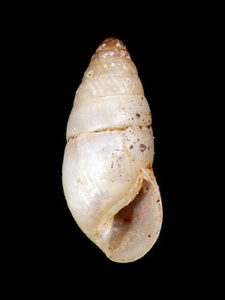
Photo: Rodrigo Salvador
(under creative commons license (3.0))
https://creativecommons.org/licenses/by/3.0/
*********************
edited: 02.05.2022
Upolu Cephalochetus Roof Beetle (Cephalochetus sp.)
This species is known only from several subfossil remains that have been recovered from samplings from the island of ‘Upolu, Samoa by Nick Porch, an Australian entomologist specialized in subfossil insect remains.
The species must have had a size of about 0,3 cm in length.
***
The genus was formerly known to occur on the Fijian Islands, so this is a new record for the Samoan Islands.
The species might quite likely be still alive, but will be mentioned here for completeness.
*********************
edited: 31.10.2020
This species is known from subfossil remains that were recovered from archaeological sites on the small island of La Desirade off the northeast coast of Guadeloupe in the Lesser Antilles.
The remains were dated to about 600 to 1400 AD.. [1][2]
*********************
References:
[1] S. T. Turvey: Holocene Extinctions. Oxford University Press, USA 2009
[2] Myriam Boudadi-Maligne; Salvador Bailon; Corentin Bochaton; Fabrice Casagrande; Sandrine Grouard; Nathalie Serrand; Arnaud Lenoble: Evidence for historical human-induced extinctions of vertebrate specieson La Désirade (French West Indies). Quaternary Research 85: 54-65. 2016
*********************
edited: 17.02.2020
Bryan’s Rhyncogonus Weevil was described in 1919, it is known from only a single specimen.
The species was endemic to the island of Laysan in the northwestern part of the Hawaiian Islands chain; its biology is completely unknown.
Bryan’s Rhyncogonus Weevil disappeared as an aftermath of the complete denudation of Laysan Island’s vegetation following the introduction of Rabbits (Oryctolagus cuniculus (L.)) in 1909.
*********************
References:
[1] G. A. Samuelson: Review of Rhyncogonus of the Hawaiian Islands (Coleoptera: Curculionidae). Bishop Museum Press, Honolulu 2003
*********************
edited: 27.01.2019
Menzies Bay Smiling Worm (Antiponemertes allisonae)
This species is a terrestrial ribbon worm, about 1 cm long and about 0.1 cm wide, with a brown mottled upper surface and relatively large eyes.
Apparently, this ribbon worm has always lived in only one place, Menzies Bay on the Banks Peninsula on New Zealand’s South Island. There the worm was found under fallen tree- or tree fern trunks, in places that were neither too wet nor too dry.
The species’ former habitat has now been largely destroyed by deforestation but also by intensive grazing by sheep, which are omnipresent in New Zealand, as well as by introduced deer.
Searches, most recently in 1988, yielded no results.
***
syn. Geonemertes allisonae Moore
*********************
edited: 25.10.2011
This form has not yet been described, it is known from subfossil remains that were recovered from substrate that was collected on the island of Mangaia, Cook Islands. [1]
*********************
References:
[1] Nick Porch; Tessa R. Smith: New Pycnomerus Erichson (Coleoptera: Zopheridae: Pycnomerini) from Rimatara, French Polynesia. Zootaxa 4237(1): 154-166. 2017
*********************
edited: 11.06.2020
Kilu Ground Pigeon (Columbidae gen. & sp.)
This up to now undescribed species is known exclusively from subfossil remains that were recovered from Holocene deposits in the Kilu Cave on the island of Buka in the northernmost part of the Solomon Islands group.
*********************
References:
[1] David W. Steadman: Extinction and biogeography of Tropical Pacific Birds. University of Chicago Press 2006
*********************
edited: 19.08.2022
The Danube Delta Dwarf Goby is a very small freshwater goby that is only known from a single small lagoon south of the Danube Delta in Romania, where it inhabited shallow brackish and fresh water, usually less than 1 m deep.
The species reached a length of only about 3 cm; it was greyish colored and its body was covered with small blackish spots.
The Danube Delta Dwarf Goby was last seen in 1994, since then it is lost without any trace and appears to be extinct.
*********************
edited: 12.05.2022
Vancouver Island Blue (Icaricia saepiolus ssp. insulanus)
The Vancouver Island Blue was described in 1920; it was restricted to Vancouver Island, British Columbia, Canada.
This taxon hasn’t been seen since 1979 and is feared to be extinct.
***
syn. Aricia saepiolus ssp. insulanus Blackmore
*********************

*********************
edited: 02.02.2024
Lesser Guam Flying Fox (Pteropus tokudae)
The Lesser Guam Flying Fox was found exclusively on the island of Guam, Marianna Islands; it shared its habitat with another flying fox species, the Larger Marianas Flying Fox (Pteropus mariannus Desmarest), which survives to this day.
The locals of the island considered both species, which they both called fanihi, as a delicacy and therefore hunted them in large numbers, which ultimately became fatal to the smaller of the two species.
The last two specimens were seen in 1967 or 1968, a female and a juvenile, the female was shot, the juvenile escaped.
All that remains of this species are two specimens (see photo).
***
The Lesser Guam Flying Fox was most closely related to the Chuuk Flying Fox (Pteropus pelagicus Kittlitz), which is common on some atolls and islands of the Chuuk Archipelago in Micronesia.
*********************

*********************
edited: 26.02.2024
Pfeiffer’s Newcombia Snail (Newcombia pfeifferi)
Pfeiffer’s Newcombia Snail was described in 1853, it inhabited the rainforests at the higher elevations in the center of Moloka’i, Hawaiian Islands.
The shells reach sizes of 1,5 to 1,7 cm in height. [1]
***
Pfeiffer’s Newcombia Snail is now considered extinct.
*********************
References:
[1] George W. Tryon; Henry A. Pilsbry; a.o.: Manual of Conchology. Second series: Pulmonata. Vol 22: Achatinellidae. 1912-1914
*********************
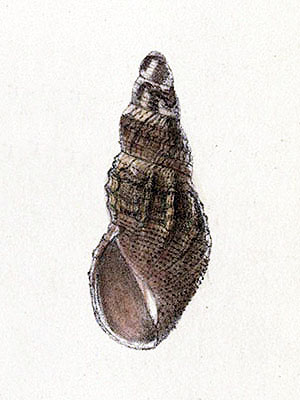
Depiction from: ‘George W. Tryon; Henry A. Pilsbry; a.o.: Manual of Conchology. Second series: Pulmonata. Vol 22: Achatinellidae. 1912-1914′
(public domain)
*********************
edited: 04.06.2021
This is another of the many beetle forms that are known only by subfossil remains, in this case found on the island of Kaua’i, Hawaiian Islands.
***
The genus Archaeoglenes has a very odd distribution, some species occur in the Caribbean, some on the Mascarene Islands, others again on the islands of the western Pacific.
*********************
edited: 31.10.2020
Flashing Leptachatina Snail (Leptachatina fulgida)
The Flashing Leptachatina Snail was described in 1911; it was found on the slopes of Pu’u Kukui and P’u Lihau in the western part of Maui, Hawaiian Islands.
The shell reaches heights of about 0.7 cm; they are imperforate, elongately ovately conic and beautifully glossy greenish yellow colored, except for the embryonic whorls which are whitish, the outer lip is dark brownish.
The species is considered extinct now.
*********************

*********************
References:
[1] George W. Tryon; Henry A. Pilsbry; a.o.: Manual of Conchology. Second series: Pulmonata. Vol 21: Achatinellidae (Amastrinae). 1911
*********************
edited: 15.01.2024
Collared Saint Helena Weevil (Acanthomerus monilicornis)
The Collared Saint Helena Weevil was described in 1869; it is, or maybe was, endemic to the island of Saint Helena, where it appears to have been quite common and widespread once.:
“This is the common Acanthomerus at Plantation, – where it swarms in the dead branches and trunks of the various species of oak, as well as in the crevices of old posts &c.; and I am inclined to think that it be should looked upon as having been attached originally to the gumwoods, which must once have been dominant throughout that district; and I have taken it amongst the gumwoods at Thompson’s Wood, where, however, it is less abundant than the A. ellipticus. At any rate it is more particularly a species of intermediate altitudes; though I believe that on one occasion I met with a single example of it towards the central ridge.” [1]
***
The species was not found during the most recent field searches and is believed to be possibly extinct.
*********************
References:
[1] T. Vernon Wollaston: Coleoptera Sanctae-Helenae. London: John Van Voorst, Paternoster Row 1877
*********************
edited: 27.05.2021
Many-toothed Saint Helena Snail (Helenoconcha polyodon)
The Many-toothed Saint Helena Snail was described in 1844 based on subfossil shells that were collected from a place named Sugarloaf Quarry on the island of Saint Helena.
The species’ author gives some information about the form of the shells.:
“This is the most widely umbilicated of all the species of Patula from St. Helena, and this feature alone is sufficient to distinguish it from the rest. The whorls also, in adult shells eight to nine in number, enlarge very slowly. The striae are fine, regular, arcuately oblique above, and slightly wavy on the last whorl. There are three parietal lirae extending far within the aperture, of which the upper and lower are nearly always double. The plicae within the outer lip are almost invariably (in adult shells) seven in number, subequidistant, but not of equal thickness, two or three towards the columella being stouter than the rest, which are slender and extend some distance within.” [1]
*********************
References:
[1] Edgar A. Smith: On the land-shells of St. Helena. Proceedings of the Zoological Society of London. 1892: 258-270
*********************

Depiction from: ‘G. W. Tryon; H. A. Pilsbry; a.o.: Manual of Conchology. Second Series: Pulmonata Vol. 8, Helicidae Vol. 6. 1892’
(public domain)
*********************
edited: 29.05.2021
This species was described in 2020, it is so far only known from the holotype material, a subfossil incomplete prosternum, that was obtained from a core sample taken from the Rairua Swamp on the island of Raivavae in the Austral Islands.
The size of this species is estimated to have been about 1,39 cm in length; it appears to have been black in color. [1]
*********************
References:
[1] Jiří Kolibáč; Milada Bocakova; James K. Liebherr; Thibould Ramage; Nick Porch: Extinct and extant Pacific Trogossitidae and the evolution of Cleroidea (Coleoptera) after the Late Triassic biotic crisis.
Zoological Journal of the Linnean Society 20: 1-37. 2020
*********************
edited: 02.11.2020
Dianchi Carp (Cyprinus micristius)
The Dianchi Carp was described in 1906; it is, or rather was, endemic to lake Dianchi in Yunnan, China.
The species was last seen in the 1960s and is now very likely extinct; it is said, however, that the tributaries of Lake Dianchi are maybe inhabited by one or more subspecies that might be still existing.
***
syn. Mesocyprinus micristius (Regan)
*********************
edited: 18.05.2022
The Jamaican Curly-tailed Lizard was described in 1966 based on fossil or subfossil left dentary that had been recovered from Dairy Cave 2,5 kilometers away from Dry Harbour in the parish of St. Ann, Jamaica, as well as several other remains from other caves on the island.
In life, the species might have reached a size of about 26 to 30 cm or even larger (including the tail). [1][2]
***
The species survived into historical times, some of the remains that have been found were unmineralized and had been collected from surface deposits. [2]
*********************
References:
[1] Richard Etheridge: An extinct lizard of the genus Leiocephalus from Jamaica. Quarterly Journal of the Florida Academy of Sciences 29(1): 47-59. 1966
[2] Gregory K. Pregill: Systematics of the West Indian Lizard Genus Leiocephalus (Squamata: Iguania: Tropiduridae). Miscellaneous Publications of the Museum of Natural History, University of Kansas 84: 1-69. 1992
*********************
edited: 07.09.2019
This species has not yet been described, it is known from subfossil remains that were recovered from substrate that was collected on the island of ‘Atiu in the Cook Islands. [1]
*********************
References:
[1] Nick Porch; Tessa R. Smith: New Pycnomerus Erichson (Coleoptera: Zopheridae: Pycnomerini) from Rimatara, French Polynesia. Zootaxa 4237(1): 154-166. 2017
*********************
edited: 11.06.2020
This species was described in 1859; it was endemic to the island of Rodrigues in the Mascarenes, however, its taxonomic status is not resolved.:
“Taxonomic issues arose concerning two species when they were submitted to experts, although they had never been reported as nonvalid species in the scientific literature; because their taxonomic status is unclear (the biological species designated by their names are unknown), they were classified as impossible to assess. However, due to this taxonomic uncertainty, no data are available apart from their original 19th-century descriptions, and the model evaluates them as extinct. These taxa are Coilostele acus and Perrottetia piriformis.” [1]
***
The genus should not be confused with the plant genus of the same name.
*********************
References:
[1] Claire Régnier; Guillaume Achaz; Amaury Lambert; Robert H. Cowie; Philippe Bouchet; Benoît Fontaine: Mass extinction in poorly known taxa. Proceedings of the National Academy of Sciences. 1-6. 2015
*********************
edited: 09.11.2021
McGregor’s House Finch (Haemorhous mexicanus ssp. mcgregori)
Described in 1897, this subspecies was restricted to the Isla de Cedros and the Islas San Benito in Baja California, Mexico.
The finches were originally described as having been very abundant and having been found all over the islands they inhabited; however, at the beginning of the 20th century, the populations begun to crash – almost certainly due to predation by introduced feral cats. The last sighting took place in 1938, then the birds were finally extinct.
***
The photo below shows an individual of another endangered island subspecies, the Guadaloupe House Finch (Haemorhous mexicanus ssp. amplus) from the Isla Guadaloupe, Baja California, Mexico.
***
syn. Carpodacus mcgregori Anthony, Carpodacus mexicanus ssp. mcgregori (Anthony)
*********************

*********************
edited: 26.08.2022
Mark’s Whorl Snail (Vertigo marki)
Mark’s Vertigo Snail was described in 1904 based on “fossil” material that was found on the Bermuda Islands.
The shells reach sizes of about 0,2 cm in height.
“This species has never been documented alive, although empty Recent shells are recorded from leaf litter around church Cave ….” [1]
*********************
References:
[1] Rüdiger Bieler; John Slapcinsky: A case study for the development of an island fauna: recent terrestrial mollusks of Bermuda. Nemouria 44: 1-99. 2000
*********************

Depiction from: ‘George W. Tryon; Henry A. Pilsbry; a.o.: Manual of Conchology. Second series: Pulmonata, Vol. 25, Pupillidae (Gastrocoptinae, Vertigininae), 1918-1920′
(public domain)
*********************
edited: 05.05.2022
Benneydale Ant-like Flower Beetle (Cotes sp.)
The genus Cotes is endemic to New Zeland, all of the about eight species currently assigned to it are probably feeding on decaying plant material.
***
The Benneydale Ant-like Flower Beetle is known only from subfossil remains that were recovered from deposits near Benneydale, a small town in the Waitomo District of western North Island, New Zealand.
This species appears to be extinct now.
*********************
References:
[1] Corinne H. Watts; Maureen J. Marra; Chris J. green; Lynette A. Hunt; Danny Thornburrow: Comparing fossil and extant beetles in central North Island forests, New Zealand. Journal of the Royal Society of New Zealand 49(1): 1-20. 2019
*********************
edited: 05.11.2020
Kalamaula Leptachatina Snail (Leptachatina emerita)
This species was described in 1900; it was endemic to the island of Moloka’i, Hawaiian Islands.
The shells reach heights of about 0.8 cm; according to the species’ author they are “variable in color, shading from brown to a hyaline tint; adult specimens lose their gloss and become of a straw-yellow. The columellar plait is small and inconspicuous.” [1]
*********************

*********************
References:
[1] George W. Tryon; Henry A. Pilsbry; a.o.: Manual of Conchology. Second series: Pulmonata. Vol 21: Achatinellidae (Amastrinae). 1911
*********************
edited: 22.01.2024
Sandwich Islands Leptachatina Snail (Leptachatina sandwicensis)
This species was described in 1846; it was endemic to the Wai’anae Mountains on the island of O’ahu, Hawaiian Islands.
The shells are about 0.78 cm heigh; they are “ovately conic, obliquely striate, subopaque, dirty corneous; spire conic, somewhat obtuse; suture marginated with an impressed line ….” [1]
*********************

*********************
References:
[1] George W. Tryon; Henry A. Pilsbry; a.o.: Manual of Conchology. Second series: Pulmonata. Vol 21: Achatinellidae (Amastrinae). 1911
*********************
edited: 14.01.2024
Southern Yellowish Amastra Snail (Amastra flavescens ssp. saxicola)
The Southern Yellowish Amastra Snail is a form of the Yellowish Amastra Snail (Amastra flavescens(Newcomb)), from the far south of the island of Hawai’i, it was found on an ancient aa (lava) flow at the foothills of the Mauna Lao volcano in the Ka’u District.
This form differs from the nominate race by its more convex whorls of which the last one is rounded peripherally. [1]
*********************
References:
[1] George W. Tryon; Henry A. Pilsbry; a.o.: Manual of Conchology. Second series: Pulmonata. Vol. 23: Appendix to Amastridae. Tornatellinidae. Index, vols. XXI-XXIII. 1915-1916
*********************
edited: 15.06.2020
Pico Rail (Rallus montivagorum)
The Pico Rail was described in 2015, it is known from subfossil material that had been collected in 2013 at a place named Furna das Torres on the island of Pico, Azores, Portugal.
The species derived from the European mainland Water Rail (Rallus aquaticus L.) and differed from that species by its slighly smaller size and a reduced sternum which indicates that it probably was completely flightless.
Some of the remains could be dated to an age of about 1405 to 1450, that is around the same time when Portugese begun to colonize the Azores. [1]
*********************
References:
[1] Josep Antoni Alcover; Harald Pieper; Fernando Pereira; Juan Carlos Rando: Five new extinct species of rails (Aves: Gruiformes: Rallidae) from the Macaronesian Islands (North Atlantic Ocean). Zootaxa 4057(2): 151-190. 2015
*********************
edited: 10.09.2019
This damselfly species, which was described in 1941, apparently was restricted to some locality in Ecuador.
There appear to be no subsequent records and it is assumed to be extinct now.
*********************
edited: 09.11.2021
Dewy Opogona Moth (Opogona irrorata)
The Dewy Opogona Moth was described in 1879; it is, or maybe was, endemic to the island of Saint Helena in the middle of the Atlantic Ocean.
The description of this species.:
“The fore wings of a pale brownish or straw-coloured tinge, and speckled with numerous irregular black dots (particularly on the basal half), each composed of a few dark scales, those near the costa having a faint tendency to be placed somewhat in transverse pairs. The apex and outer margin are speckled more minutely, as is also the fringe. Hind wings pale glossy cinereous, and, when viewed beneath a high magnifying-power, with a pearly and somewhat opaline lustre. Thorax slightly darker than the anterior wings; body much the same as the posterior ones.
The only examples which I have seen of this moth I captured, I believe, at Thompson’s Wood; but whether the species is in any way connected with the gumwoods I have no means of deciding. At any rate there is no reason to suspect that it is otherwise than truly indigenous in the island. The rather dotted, or speckled, surface of its upper wings will be sufficient to distinguish it from its more immediate allies.” [1]
***
The species was never found again and is quite likely extinct. [2]
*********************
References:
[1] Mrs. T. Vernon Wollaston: Notes on the Lepidoptera of St. Helena, with descriptions of new species. The Annals and Magazine of Natural History, including Zoology, Botany, and Geology. Ser. 5. Vol. 3: 415-441. 1879
[2] Timm Karisch: Darwin-Plus Project DPLUS040: securing the future for St Helena’s endemic invertebrates. Report Lepidoptera. Dessau, 31.08.2018
*********************
edited: 28.05.2021
The Giant Elephant Bird was originally described in 1894, however, the whole elephant bird family was in urgent need of a proper revision, which indeed took place in 2018 and which lead to a reduction of the number of species and the description of a completely new genus for the largest of the species. [1]
The species must have reached a size of 3 m and must have weighted up to 730 kg, making it the heaviest known bird, dead or alive.
The Giant Elephant Bird died out shortly after the arrival of humans on the island of Madagascar, most likely due to habitat destruction and overhunting.
*********************
References:
[1] James P. Hansford; Samuel T. Turvey: Unexpected diversity within the extinct elephant birds (Aves: Aepyornithidae) and a new identity for the world’s largest bird. Royal Society Open Science 5(9): 1-28. 2018
*********************
edited: 22.01.2022
Linsley’s Spreadwing was described in 1960, it apparently occurs, or maybe occurred near Port Moresby, the capital of Papua New Guinea.
The species has a wingspan of about 4,4 cm; the males have distinctly shaped hindwings with a rounded flap in the anal region. [1]
It is now thought to be possibly extinct.
*********************
References:
[1] Vincent Kalkman; Albert Orr: Field Guide to the damselflies of New Guinea. Brachytron 2013
*********************
edited: 13.11.2021
The Kula Amastra Snail was described 1873; it inhabited the forests around Kula in the northern part of eastern Maui, Hawaiian Islands, where it usually was found under dead leaves on the ground.
The shells reached sizes of up to 1,7 cm in height; they are ovate-conic, dextral, lightly striated with lines of growth, they are very pale reddish and partly covered with a brownish-olivaceous epidermis. [1]
*********************
References:
[1] George W. Tryon; Henry A. Pilsbry; a. o.: Manual of Conchology. Second series: Pulmonata. Vol 21: Achatinellidae (Amastrinae). 1911
*********************

Depiction from: ‘George W. Tryon; Henry A. Pilsbry; a. o.: Manual of Conchology. Second series: Pulmonata. Vol 21: Achatinellidae (Amastrinae). 1911’
(public domain)
*********************
edited: 16.05.2022
Nauru Rail (Gallirallus sp.)
“Es gibt auch Vögel auf Nauru, wie Fregattvogel, schwarze Seeschwalbe, weiße Seeschwalbe, Regenpfeifer, Brachvogel, Möve, Schnepfe, Uferläufer, Ralle, Lachmöve und Rohrdrossel.”
translation:
“There are also birds on Nauru, as frigate bird, black tern, white tern, plover, curlew, gull, snipe, sandpiper, rail, black-headed gull and reed thrush.“
and …
“Die Vogelwelt ist nach Zahl und Art reicher. Der Fregattvogel (Tachypetes aquila), itsi, die schwarze Seeschwalbe (Anous), doror, die weiße Seeschwalbe (Gygis), dagiagia, werden als Haustiere gehalten; der erste galt früher als heiliger Vogel, mit den beiden anderen werden Kampfspiele veranstaltet. Am Strande trifft man den Steinwälzer (Strepsilas interpres), dagiduba, den Regenpfeifer (Numenius), den Uferläufer (Tringoides), ibibito, die Schnepfe, ikirer, den Brachvogel ikiuoi, den Strandreiter iuji, die Ralle, earero bauo und zwei Möwenarten (Sterna), igogora und ederakui. Im Busche beobachtet man an den Blüten der Kokospalme den kleinen Honigsauger raigide, die Rohrdrossel (Calamoherpe syrinx), itirir und den Fliegenschnäpper (Rhipidura), temarubi.” [1]
translation:
“The bird world is richer by number and species, The frigate bird (Tachypetes aquila), itsi, the black tern (Anous), doror, the white tern (Gygis), dagiagia, are kept as pets; the first one was formerly considered a holy bird, with the two others are used for fighting games. At the beach one mets with the turnstone (Strepsilas interpres), dagiduba, the plover (Numenius), the sandpiper (Tringoides), ibibito, the snipe, ikirer, the curlew, ikiuoi, the beach rider [?] iuji, the rail, earero bauo and two gull species (Sterna), igogora and ederakui. In the bush one observes on the flowers of the coconut palm the small honeyeater raigide, the reed thrush (Calamoherpe syrinx), itirir and the flycatcher (Rhipidura), temarubi.“
These two accounts, made in the early 20th century both mention a form of rail that inhabited the island of Nauru; for biogeographical reasons, this almost certainly was a flightless endemic species, which is now extinct without leaving behind any traces.
*********************
References:
[1] Paul Hambruch: Nauru. Ergebnisse der Südsee-Expedition 1908-1910. II. Ethnographie: B. Mikronesien, Band 1.1 Halbband. Hamburg, Friedrichsen 1914
*********************
edited: 04.01.2024
Small Spur-throat Grasshopper (Melanoplus nanus)
The Small Spur-throat Grasshopper was described in 1898, it was apparently only found in few places in the Alameda – , the Marin – , and the San Mateo Counties in California, USA.
The species inhabited dry grassy hillsides.
The males reached sizes of about 1,4 cm, the females were slightly larger, both sexes were fuscous light-brown colored.
The Small Spur-throat Grasshopper is now considered possibly extinct, however, reasons for this assumption are not given.
********************
References:
[1] Samuel H. Scudder: Supplement to a revision of the Melanopli. Proceedings of the Davenport Academy of Natural Sciences 7: 157-205. 1899
********************

********************
edited: 31.08.2019
Koa Blackburnia Ground Beetle (Blackburnia agonoides)
The Koa Blackburnia Ground Beetle was described in 1903, it was endemic to the island of Maui, Hawaiian Islands.
The species was recorded from cavities in trunks or branches of the endemic Koa (Acacia koa A. Gray). [1]
*********************
References:
[1] Dan A. Polhemus; Curtis P. Ewing; R. Kaholo’a, James K. Liebherr: Rediscovery of Blackburnia anomala (Coleoptera: Carabidae), in East Maui, Hawai’i, after a 107-year hiatus. Pacific Science 57(2): 16-166. 2003
*********************
edited: 03.09.2019
Elliot’s Cave Snail (Damonita geminoropiformis)
This tiny snail species was described in 1981, it was originally known from only two specimens that were recovered from the deposits of Elliots Cave as well as ten that were found in the Ngarua Cave in the Takaka Valley.
Some 103 specimens were subsequently recovered from the Hawke’s Cave in the 1990s; these deposits are dated to Otiran age (Late Pleistocene); however, it might have survived until the beginning of the Holocene and is thus mentioned here as well.
The shells reach a size of about 0,3 cm in diameter and are highly furrowed.
*********************
References:
[1] T. H. Worthy; R. N. Holdaway: Quaternary fossil faunas from caves in Takaha Valley and on Takaka Hill, northwest Nelson, South Island, New Zealand. Journal of the Royal Society of New Zealand 24(3): 297-391. 1994
*********************
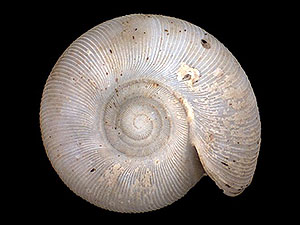
*********************
edited: 15.05.2021
Wailuku Pug Moth (Eupithecia dryinombra)
The Wailuku Pug Moth was described in 1899, it is known only from the male type specimen.
The species reaches a wingspan of about 1,7 cm, it is rather pale and narrow-winged, there are obscure medial bands on its forewings that are marked by a series of short, disconnected longitudinal dashes.
The species inhabited the native rain forest above a place named Wailuku on the island of Moloka’i, Hawaiian Islands, a habitat that is now heavily degraded by introduced mammalian herbivores.
The Wailuku Pug Moth was never recorded since its description and is likely extinct. [1][2]
*********************
References:
[1] E. C. Zimmerman: Insects of Hawaii 7, Macrolepidoptera. University of Hawaii Press, Honolulu 1958
[2] Steven L. Montgomery: Carnivorous caterpillars: The behavior, biogeography and conservation of Eupithecia (Lepidoptera: Geometridae) in the Hawaiian Islands. GeoJournal 7.6: 549-556. 1983
*********************
edited: 06.01.2019
Benneydale Ironclad Beetle (Pycnomerus sp.)
This up to now undescribed species is known exclusively from subfossil remains that were recovered from deposits near Benneydale, a small town in the Waitomo District of western North Island, New Zealand. [1]
The species is now extinct, it is one of countless large insect species that were eaten into extinction by Polynesian Rats (Rattus exulans (Peale)) that had been introduced by the ancestors of the Maori when they first arrived in New Zealand.
*********************
References:
[1] Corinne H. Watts; Maureen J. Marra; Chris J. green; Lynette A. Hunt; Danny Thornburrow: Comparing fossil and extant beetles in central North Island forests, New Zealand. Journal of the Royal Society of New Zealand 49(1): 1-20. 2019
*********************
edited: 05.11.2020
Lord Howe Swallowtail (Graphium macleayanum ssp. insulana)
Macleay’s Swallowtail (Graphium macleayanum (Leach)) is an Australian butterfly species that contains three subspecies, of which two occur in Australia while the third one was restricted to Lord Howe Island.
The larvae feed on several plant species from the Atherospermataceae, the Lauraceae and the Winteraceae.
The Lord Howe subspecies, described in 1920, was last seen in 1893 and is now obviously extinct.
***
The photo below shows the south-eastern Australian subspecies of Macleay’s Swallowtail (Graphium macleayanum ssp. moggana Couchman).
*********************
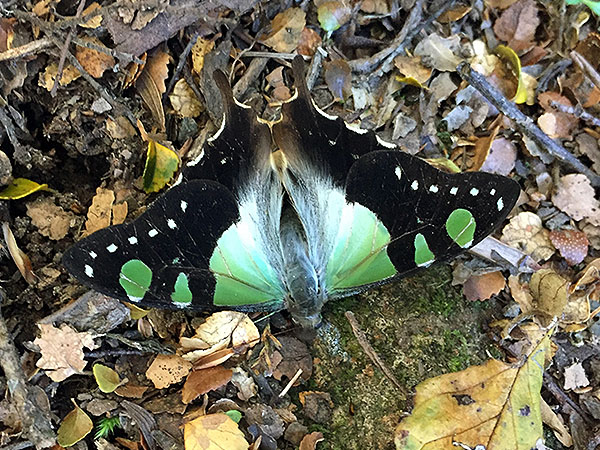
*********************
edited: 02.02.2024
Ampoza Ground Roller (Brachypteracias langrandi)
The Ampoza Ground Roller was described in 2000 on the basis of a single subfossil humerus that had already been discovered in 1929 at Ampoza in central south-western Madagascar.
The locality lies within the dry deciduous forest region and is obviously not inhabited by any species of the Brachypteraciidae family, which, except for one species, prefer humid forests and rainforests.
The species disappeared sometimes after the coloniuation by human settlers due to human-induced climate changes that led to the desertification of many of Madagascar’s regions.
***
The depiction below shows the sole still living member of the genus, the Short-legged Ground Roller (Brachypteracias leptosomus (Lesson)).
*********************

*********************
References:
[1] Steven M. Goodman: A description of a new species of Brachypteracias (Family Brachypteraciidae) from the Holocene of Madagascar. Ostrich. 71(1-2): 318-322. 2000
*********************
edited: 28.02.2024
Antigua Amazon (Amazona vittata ssp.)
This form is known from at least two subfossil bones recovered from archaeological sites on the island of Antigua, which were identified as being identical to the Puerto Rican Amazon (Amazona vittata (Boddaert)).
It is of course possible that the species was brought to the island by early human settlers, which apparently have always hunted parrots for food but have also kept them as pets and transported them from one place to another. The neighboring island of Barbuda, however, is known to once have harbored a native population of this species or maybe a very closely related one, so it is likely that the same form, or rather a subspecies of it inhabited Antigua as well. [1]
*********************
References:
[1] Charles A. Woods; Florence E. Sergile: Biogeography of the West Indies: Patterns and Perspectives, Second Edition. CRC Press; Auflage: Subsequent 2001
*********************
edited: 13.02.2020
The Black Sea Freshwater Snail was descried in 1987; it is known only from Holocene deposits; it is known exclusively from subfossil shells that were recovered from Holocene deposits near the coast of the Crimea Peninsula, Ukraine.
The species disappeared for natural reasons. [1]
*********************
References:
[1] Frank P. Wesselingh; Thomas A. Neubauer; Vitaliy V. Anistratenko; Maxim V. Vinarski; Tamara Yanina; Jan Johan ter Poorten; Pavel Kijashko; Christian Albrecht; Olga Yu. Anistratenko; Anouk D’Hont; Pavel Frolov; Alberto Martínez Gándara; Arjan Gittenberger; Aleksandre Gogaladze; Mikhail Karpinsky; Matteo Lattuada; Luis Popa; Arthur F. Sands; Sabrina van de Velde; Justine Vandendorpe; Thomas Wilke: Mollusc species from the Pontocaspian region – an expert opinion list. ZooKeys 827: 31-124. 2019
*********************
edited: 18.11.2021
Shi-Kuei’s Tryonia (Tryonia shikueii)
This species was described in 2014, it is known from two populations inhabiting Ojo de Federico and Ojo de San Juan, two closely proximal springs in the lower Río Casas Grandes basin with water temperatures around 23 °C to 27°C.
The two localities dried out sometimes in the 1980s, which means that both populations of this species are lost leading to its extinction. [1]
*********************
References:
[1] Robert Hershler; J. Jerry Landye; Hsiu-Ping Liu; Mauricio De la Maza-Benignos; Pavel Ornelas; Evan W. Carson: New species and records of Chihuahuan Desert springsnails, with a new combination for Tryonia brunei. Western North American Naturalist 74(1): 47-65. 2014
*********************
edited: 02.05.2019
Aldrich’s Plant Bug (Taylorilygus aldrichi)
Aldrich’s Plant Bug was described in 1936 on the basis of material that had been collected in 1933 on Christmas Island, Australia.
The species has not been recorded since and appears to be extinct now.
***
syn. Lygus aldrichi Izzard
*********************
References:
[1] John Woinarski: A Bat’s End: The Christmas Island Pipistrelle and Extinction in Australia. CSIRO Publishing, Victoria, Australia 2018
[2] D. J. James; P. T. Green; W. F. Humphreys; J. C. Z. Woinarski: Endemic species of Christmas Island, Indian Ocean. Records of the Western Australian Museum 34: 55-114. 2019
*********************
edited: 16.02.2024
Samoan Megapode (Megapodius pritchardii ssp.)
This taxon is known exclusively on the basis of subfossil bones, found on the small island of Ofu, part of ‘American’ Samoa.
The remains were tentatively identified as possibly belonging to the Tongan Megapode (Megapodius cf. pritchardii), if so, they may have been a local subspecies. [2]
***
This form may be the bird that was described (as Megapodius stairi Gray) based on a single egg found on the island of Savai’i.:
“Nach Bennett (Proc. 1862. p. 247) erhielt Dawson auch die lebenden Vögel auf Sava- oder Russel-Island, die indess leider auf der Ueberfahrt nach Sydney starben. Die Eingeborenen kennen diese Hühner sehr gut und sammeln die Eier fleissig, mit welchen sie Handel treiben. Ein Weibchen legt täglich 2-4 Eier.”
translation:
“According to Bennett (Proc. 1862. p. 247) Dawson obtained also the life birds on Sava- or Russel Island [Savai’i], which, however, unfortunately died during the crossing to Sydney. The natives know these chickens very well and diligently collect the eggs, with which they trade. A female lays 2-4 eggs on the daily [I personally doubt that number!].” [1]
*********************
References:
[1] O. Finsch; G. Hartlaub: Beitrag zur Fauna Centralpolynesiens. Ornthologie der Viti-, Samoa- und Tonga-Inseln. Halle, H. W. Schmidt 1867
[2] David W. Steadman: Extinction and biogeography of Tropical Pacific Birds. University of Chicago Press 2006
*********************
Cooke’s Georissa Snail (Georissa cookei)
Cooke’s Georissa Snail was described in 1928, it is known only from the island of Kaua’i, Hawaiian Islands.
The shell of this microscopic species reached sizes of only about 0,085 to 0,1 cm, they were composed of three and a half strongly convex whorls and were orange-cinnamon in color. [1]
***
According to a study from 2018 all (two or three) endemic Hawaiian members of the family Hydrocenidae are now extinct. [2]
*********************
References:
[1] Henry A. Pilsbry; C. Montangue Cooke Jr.; Marie C. Neal: Land Snails from Hawaii, Christmas Island, and Samoa. Bishop Museum Bulletin 47: 1-49. 1928
[2] Norine W. Yeung; Kenneth A. Hayes: Biodiversity and extinction of Hawaiian land snails: how many are left now and what must we do to conserve them – a reply to. Integrative and Comparative Biology 58(6): 1157-1169. 2018
*********************
edited: 08.05.2019
Tecopa Pupfish (Cyprinodon nevadensis ssp. calidae)
The Tecopa Pupfish was described in 1948, it was restricted to some outlets of the North- and South Tecopa Hot Springs in Inyo County, California, USA.
The two hot springs that this fish inhabited were very popular in the 1950s and 60s and were used for recreationally purposes; bathhouses were built, the spring pools were enlarged and their outflows were diverted which resulted in swifter currents which again caused the water temperatures downstream to rise above the level to which this pupfish was adapted.
All these modifications also allowed a subspecies closely related to this form, the Amargosa River Pupfish (Cyprinodon nevadensis ssp. armagosae Miller), to invade the Tecopa Pupfish’s habitat and to hybridize with it.
The last presumed Tecopa Pupfishs were recorded in 1966, but these, having ‘too small’ scales, may already have been hybrids.
*********************
edited: 27.05.2019
Long-bellied White-legged Damselfly (Proplatycnemis longiventris)
This species is known only by its type which had been collected in 1933 or -34 from the vicinity of the city of Ambanja at the Sambirano River in north-western Madagascar.
The status of this species is currently unknown, but it could potentially be extinct.
***
syn. Platycnemis longiventris Schmidt
*********************
edited: 24.08.2022
Murray’s Plant Bug (Taylorilygus murrayi)
This species, which is endemic to Christmas Island in the Indian Ocean, was last recorded in 1933, it may now be extinct. [1]
There appear to exist no further information about this species.
***
syn. Lygus murrayi Izzard
*********************
References:
[1] John Woinarski: A Bat’s End: The Christmas Island Pipistrelle and Extinction in Australia. CSIRO Publishing, Victoria, Australia 2018
[2] D. J. James; P. T. Green; W. F. Humphreys; J. C. Z. Woinarski: Endemic species of Christmas Island, Indian Ocean. Records of the Western Australian Museum 34: 55-114. 2019
*********************
edited: 16.02.2024
South-East African Burrowing Grasshopper (Acrotylus mossambicus)
The South-East African Burrowing Grasshopper was described in 1893, it apparently is widely distributed over parts of Mozambique, South Africa, Tanzania and Zimbabwe.
The species has apparently not been recorded since 1946 and might be extinct, however, given its wide distribution this assumption seems quite strange.
*********************
edited: 03.11.2020
This freshwater mussel species is, or maybe was, endemic to Lake Victoria, where it appears to have inhabited an only about 10 km² large area.
The species was not recorded in recent surveys (actually it has not been recorded for over 100 years), it might have fell victim to the human-induced pollution and sedimentation of the lake and is now very likely extinct.
*********************
edited: 14.11.2021